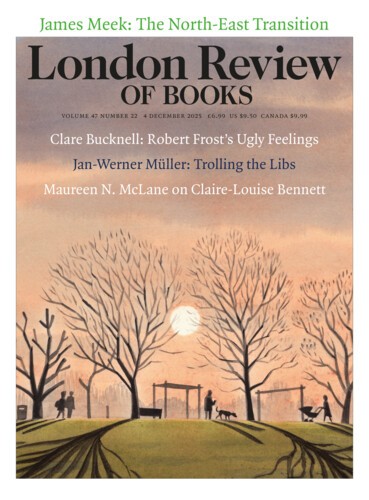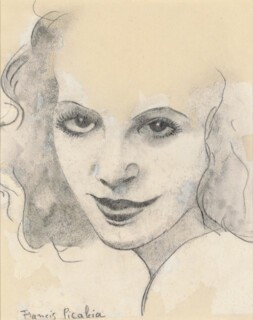For a long stretch of her long life, Jean Rhys was thought to be dead: drowned in the Seine, they said. For some of it she was thought to be a fraud. In 1949 a neighbour in Beckenham who knew her by the name of her husband (who was a real fraud) accused her of impersonating the famous author Jean Rhys. ‘I feel rather tactless being still alive,’ she wrote to her daughter. She often said she felt like a ghost, and sometimes like a ghost’s technological equivalent: ‘A writer is only a telephone.’
Hilton Als, who has curated exhibitions inspired by Joan Didion and James Baldwin, has now created one about Rhys. Postures: Jean Rhys in the Modern World, recently on display at London’s Michael Werner Gallery, does not try to cover all Rhys’s glimmers in and out of vivacity. Nevertheless there is a spectral quality to this ‘collective portrait’, which includes no actual portrait of Rhys herself. Paintings, sculptures, photographs – and one dress – from the 18th to the 21st century are shown alongside extracts from Rhys’s writing, without further explanation. Als has said he wanted to make ‘an emotional transcription of how she makes me feel’. Which raises the question of who this exhibition is about, whose postures these are.
Guesswork and free association are required. A few works evidently summon Wide Sargasso Sea. A sumptuous untitled painting by Hurvin Anderson is a direct reaction: tall flames leaping up from a house, a dark horse, a background of that ‘extreme green’ that so disturbs the male narrator. A graceful engraving by Agostino Brunias shows ‘Free Natives of Dominica’. Hans Bellmer’s spooky dolls (what dolls are not spooky when not held by a child?) might serve as a reminder that the heroine has in unhappiness a ‘doll’s smile’, that Antoinette is also a marionette. Elsewhere, a Eugène Atget photograph of some stocky prostitutes provides a more companionable view of the Paris of After Leaving Mr Mackenzie. If only it had been accompanied by a quotation from Rhys’s favourite novel about a demi-mondaine: The Sands of Pleasure by Filson Young.
There is a thin line between the tangential and the bafflingly oblique. Celia Paul’s simmering portrait of Charlotte Brontë – eyes down, mouth set, raw-boned, wary, building to thunder – is a hot line to the person who created Bertha Mason. Yet a few feet away is Gwen John’s Girl in a Red Shawl, in creams and rusts, with no harsh lines but very exact hair, looking like a mural in the process of being uncovered. Without a linking narrative it is not easy to decide what might bring the paintings by John and Paul together: their centre partings? Their lack of grinning? Or are both brought into the Rhys ambit by a narrative of the once neglected female artist, a narrative which clings even after triumph.
One of the people responsible for Rhys’s eventual triumph, for bringing her work back into print, was Francis Wyndham, whose account of her as friend and writer is robust and far reaching. He found a feeling of the 1960s in her work, with its ‘elegant surface and the paranoid content’. He knew her as a ‘slant-eyed siren’, a delighter in ‘sacred moments of frivolity’ which ‘nearly made life worth living’. There is little of that here, save in some free-flowing Francis Picabia drawings of women with bow lips and skinny eyebrows. The item that might have been expected to bring Rhys physically closer is one of the most alienating. A cotton house dress, dating from just before the First World War, which belonged to Rhys, has already had its own after-story in an essay by Sophie Oliver. Red and blue, patterned with white chrysanthemums, it loses its life on a dumpy model stand; it’s hard to picture it on a woman who wrote of prising herself out of black into grey and navy. Too solid for a siren.
The most purposeful of Als’s rooms is dedicated to a different Rhys afterlife: her influence on writers from the Caribbean. Here are 69 photographs of Dominica, along with photographs of Jamaica Kincaid, Caryl Phillips – whose novel A View of the Empire at Sunset is based on Rhys’s life – and Derek Walcott, whose poem ‘Jean Rhys’ was published in the New Yorker in 1980 (‘the bay below is green as calalu, stewing Sargasso’). The collection highlights the limitation of the English responses to Rhys’s work when I first read it in the 1970s. For a long time there was an assumption that most readers would be blank about the Caribbean: my Penguin Classics edition of Wide Sargasso Sea from 2000 has a footnote explaining what a mango is. Although there is no picture of Rhys on display, her words wheeze around the room in a radio recording: the 1957 Third Programme broadcast of Good Morning, Midnight, arranged and performed by the actress Selma Vaz Dias. Vaz Dias had played the part of a lying passenger in The Lady Vanishes: ‘There has been no English lady here.’
Send Letters To:
The Editor
London Review of Books,
28 Little Russell Street
London, WC1A 2HN
letters@lrb.co.uk
Please include name, address, and a telephone number.


